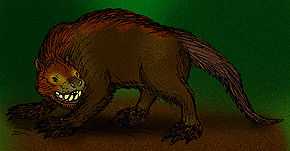Taeniodont
| Taeniodonts Temporal range: Late Cretaceous - Eocene, 66–37Ma | |
|---|---|
 | |
| Stylinodon mirus | |
| Scientific classification | |
| Kingdom: | Animalia |
| Phylum: | Chordata |
| Class: | Mammalia |
| Order: | †Cimolesta |
| Suborder: | †Taeniodonta |
| Families | |
|
Conoryctidae | |
Taeniodonta ("banded teeth") is an extinct early group of mammals known from the Palaeocene to the Eocene. Taeniodonts evolved quickly into highly specialized digging animals, and varied greatly in size, from rat-sized to species as large as a bear. Later species developed prominent front teeth and huge claws for digging and rooting. Some genera, like Stylinodon, had ever-growing teeth.[1]
Two families belong to this group, Stylinodontidae and Conoryctidae. They were endemic to North America. The scarcity of taeniodont fossils can be explained by the fact that these animals probably lived in the drier parts of the continent where fossilization was less frequent. Taeniodonts may be related to Cimolesta, but they're unambiguously non-placental eutherians.[2]
Taxonomy
From Thomas E. Williamson and Stephen L. Brusatte (2013):[3]
- Order Cimolesta
- Suborder Taeniodonta
- Alveugena
- Schowalteria
- Onychodectes
- Family Conoryctidae
- Conoryctella
- Huerfanodon
- Conoryctes
- Family Stylinodontidae
- Wortmania
- Psittacotherium
- Ectoganus
- Stylinodon
Notes
- ↑ Cox et al. 1988, p. 237
- ↑ Rook & Hunter 2013
- ↑ Williamson, T. E.; Brusatte, S. L. (2013). "New Specimens of the Rare Taeniodont Wortmania (Mammalia: Eutheria) from the San Juan Basin of New Mexico and Comments on the Phylogeny and Functional Morphology of "Archaic" Mammals". In Viriot, Laurent. PLoS ONE 8 (9): e75886. doi:10.1371/journal.pone.0075886.
References
- Cox, Barry; Savage, R.J.G.; Gardiner, Brian; Dixon, Dougal (1988). "Early rooters and browsers". Macmillan Illustrated Encyclopedia of Dinosaurs and Prehistoric Animals. Macmillan London Limited. ISBN 0-333-48699-4.
- McKenna, Malcolm C.; Bell, Susan K. (1997). Classification of Mammals Above the Species Level. New York: Columbia University Press. ISBN 0231110138. OCLC 37345734.
- Rook, D.L.; Hunter, J.P. (2013). "Rooting Around the Eutherian Family Tree: the Origin and Relations of the Taeniodonta". Journal of Mammalian Evolution: 1–17. doi:10.1007/s10914-013-9230-9. Retrieved May 2013.